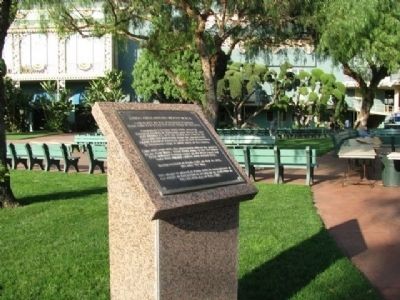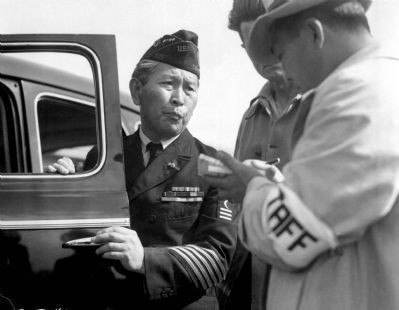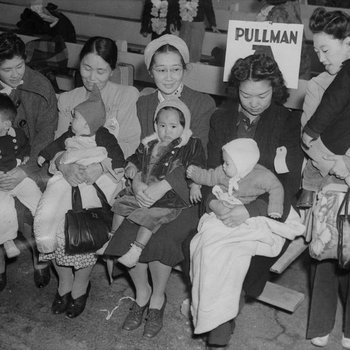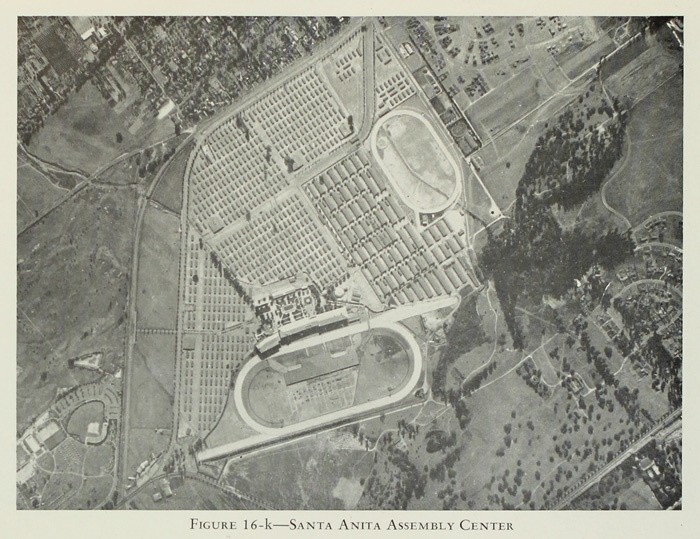Santa Anita Park During World War II-Japanese Relocation and Military Training Centers
Introduction
Text-to-speech Audio
Images
The marker near the grandstand commemorating the use of Santa Anita Park during WWII.

An unidentified navy veteran of Japanese ancestry reports to the assembly center for processing.

Families Awaiting to be processed

Arial View of Race Track after Converted into Camps

Backstory and Context
Text-to-speech Audio
When Japanese Americans arrived, they were given an army cot, blanket and straw tick which they used in rows and rows of barracks that were constructed on the park's parking lot. More than 8,000 lived in converted horse stables that some claimed never lost the stink of manure. The race track was surrounded with barbed wire and searchlights.
Once the Japanese Americans has been evacuated to their respective internment camps, the park was converted to an army base. where more than 100,000 soldiers were trained in weapons, ammunition and combat vehicles.
In 2001, a marker was placed close to the grandstand of the racetrack commemorating this segment of the racetrack's history.
Its February 19,1942, President Roosevelt just announced the actions of Executive Order 9066 which declared all Japanese American citizens to be relocated into temporary internment camps across America. In order for them to go to certain camps each Japanese American citizen had to go through a processing center and then waited to be relocated to a camp. These processing centers were just holding areas for the time being. Santa Anita Race Track in California was used for one of those centers. It housed over 8000 Japanese American
With the government building the barracks on site officials also made old horse stables living quarters for people with only a cot, a blanket to sleep with. Families could only bring a bag of belongings and had to leave behind all other goods. George Takei whom was a young boy at the time he was taking to his processing camp in the Northern California area was then relocated to an Arkansas Camp. When the citizens arrived to the centers they were given a meal card, ID number and then waited days, weeks, or months to get put into a interment
Over time Executive order 9066 processed and incarnated over 120,000 Japanese American citizens.[1] Most of these families came from 2nd and 3rd generations of Japanese families and were called Issei and Nisei. They were also called cultural traitors. Around this time of February Three months after Pearl Harbor, Japanese Americans’ constitutional rights no longer existed. Japanese American people could not leave the country, because all of their assets had been frozen when the initial raids occurred. The Issei generations could not become American citizens and thus were labeled as “enemy alien.” The right to sign up for the draft during the start of the war was denied due to being of Japanese descent. Rights and duties as simple as buying gasoline were halted due to panic of threat. At the end of February a committee that was created by the House of Representatives, which investigated the national defense migration, held hearings about what action should be taken for the Japanese “enemy aliens”. It was until John Tolan of the Democratic Party that said, “If it is necessary from a danger standpoint the United States should evacuate all Japanese Americans into camps.”[2] The Japanese were dehumanized as soon as they arrived to the camps. They only had the clothes on their backs and the few they were able to take from their homes. In California camps especially, it was the norm to use abandoned racehorse stables as homes. Most camps only had metal cots with hay mattresses, and never had enough to stay warm in the harsh weather conditions. Though the treatments were insensitive and immoral, the Japanese spirit stayed strong and gave them a sense of great community for one another. Although they were in these camps out of punishment for their cultural heritage, they managed to keep their traditions alive through the tough times.[3]George Takei put it the best way, “Our democracy and be just as great as the people but can also be just as fallible as the people.” Looking back through history and when Pearl Harbor happened, America, was terrified and needed to do something. At the time this was that something. We at times now have entered the same paradox. Not to far from here San Bernadino was attacked by terrorists and multiple attacks around the world had happened. At that time the world was scared, an American official gave rise to this idea again, about labeling Muslim people. We learn from our mistakes in history not repeat them. We cannot be a great country if we separate each other. United We Stand, Divided We Fall.
Cite This Entry
Booton, Kristi et. al. "Santa Anita Park During World War II-Japanese Relocation and Military Training Centers." Clio: Your Guide to History. February 25, 2018. Accessed March 31, 2025. https://theclio.com/tour/257/1

